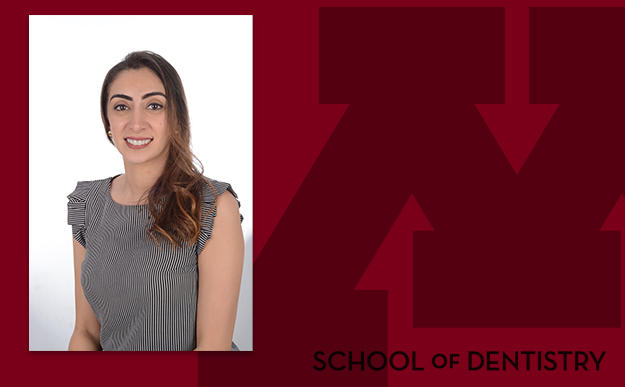Falling in love with the puzzle of orofacial pain

For Maram Taema, DDS, graduate resident in TMD and Orofacial Pain, choosing a career path was as easy as falling in love.
Growing up in Egypt in a family of medical professionals, Taema knew health care was in her future—but she saw dentistry as her path forward. She excelled in her coursework, becoming a faculty member in prosthodontics and pursuing her master’s degree and PhD. That’s when she first discovered TMD and Orofacial Pain—and fell hard.
It began with a thesis project that sparked Taema’s creative problem solving instincts and her feminist roots. “TMD and Orofacial Pain tends to impact women more, and that felt like a challenge to me,” she explained. “With the medical field dominated by men, and pain being subjective, I really wanted to listen to these women and help them.”
Solving the challenge of orofacial pain would not prove to be easy—but that’s exactly what Taema loves about it. “It’s like a puzzle, where you have to collect all the pieces to see the whole picture,” she explained.
Tamea loved solving that puzzle so much that she decided to pursue a specialty residency at the University of Minnesota, where she could continue to grow in her understanding of the complexity of oral and facial pain. And it’s everything she hoped it would be.
“I wake up every morning excited to see my patients,” she said. “I really enjoy what I do.”
In addition to her studies, Taema is a support system for DDS learners interested in exploring orofacial pain. DDS students shadow Taema and her co-residents in the clinic, and she has created a mini-program, TMD diagnosis lectures and more to empower their learning. She organized a Botulinum toxin training workshop and a Resident Education for the Assessment and Care of Headache program for residents—the first training of its kind to be done at the School of Dentistry.
“I love teaching students in a way that makes them ask questions,” she said. “I don’t want to just give them facts. I want them to think about how they can make the world a better place.”
She hopes to make this process as effective as possible for learners—studying the educational quality of the orofacial pain program and providing suggestions to improve it as necessary.
Taema also asks herself how she can make the world a better place. For now, that looks like completing her residency, exploring headaches from the dental perspective and studying the factors associated with persistent pain following root canal treatment. Eventually, she hopes to return home and establish an orofacial pain specialty in Egypt.
Every step of the way, she aims to make sure that she’s putting her patients and their needs first. “We have to treat the patient as a whole,” she explained. “Our patients have other things going on in their life, and when it comes to pain, everything is connected. We can address a lot when we see the whole person.”
Taema works hard, and education has been a big part of her life. She’s proud of the work she’s done, and knows her journey has only just begun.
“I think you can never grow old on learning,” she reflected. “You can always learn more. I’m a living example of that.”